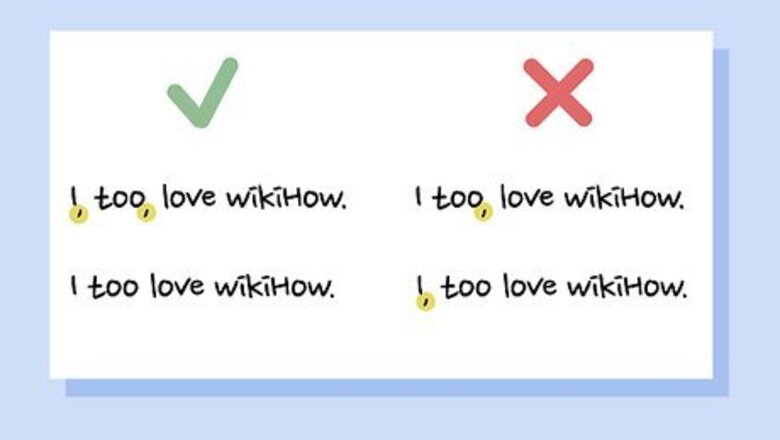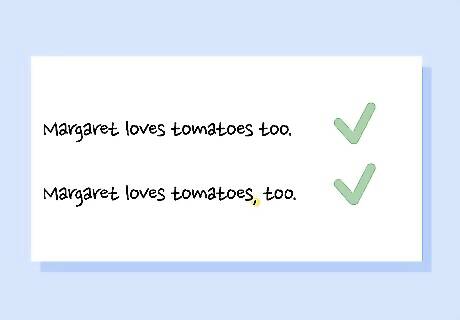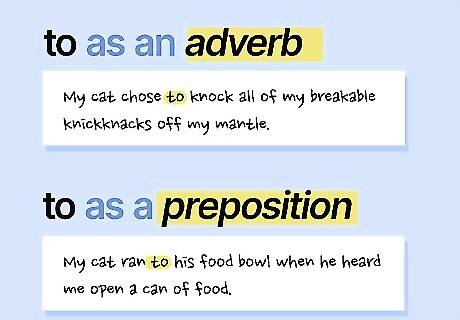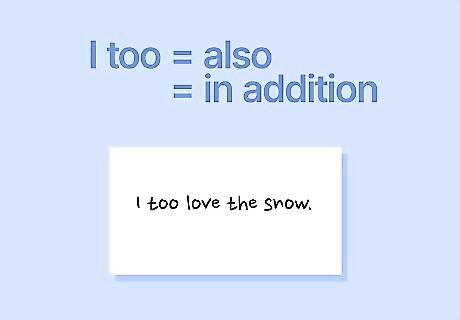
views
- "I, too," is more traditionally used, but "I too" is also grammatically correct.
- Use either no commas at all ("I too") or 2 commas ("I, too,"). It’s not correct to use just one comma.
- Don’t use a comma before “too” at the end of a sentence.
- Use “too” in place of “also,” “as well,” or “in addition.” Use “to” in reference to movement in a certain direction.
Is it "I too" or "I, too"?

"I, too," is more traditional, but "I too" is acceptable. It's commonly considered correct to use commas around the word “too” when it appears in the middle of a sentence—for instance, “I, too, enjoy a good banana”—but it's not totally necessary, and odds are your English teacher won't be a stickler about it. That said, be sure to use either no commas at all or 2 commas—one before and one after “too.” It’s not correct to only use one comma. Correct: “I, too, love wikiHow.” or “I too love wikiHow.” Incorrect: “I too, love wikiHow.” and “I, too love wikiHow,”

Use commas around "too" to slow the flow of your sentence. Sometimes, depending on the sentence you’re writing, you may want to indicate a pause before and after “too,” in which case commas are helpful. They can indicate a change of thought mid-sentence, or they can contribute to a more thoughtful, meditative tone. Say these 2 sentences out loud: “I, too, know how to juggle,” and “I too know how to juggle.” The first one feels a bit slower and more thoughtful, right? Meanwhile, the second one has a more rapid flow.

Use commas around "too" in the middle of a sentence to enhance clarity. You'll generally be OK if you don't use commas around "too" when it appears in the middle of a sentence, but sometimes, if a sentence is more involved, commas can aid in reader comprehension. The pause indicated by commas can help clarify the meaning of an otherwise long or confusing sentence. A simple sentence like "I too love bagels" is pretty straightforward, meaning you'd probably be OK omitting commas. On the other hand, a longer sentence like "The Douglass triplets too go for walks in the evening" would benefit from being broken up by commas around "too." Notice the difference: "The Douglass triplets, too, go for walks in the evening."
Grammar Rules for Using "Too"

You may omit a comma before “too” at the end of a sentence. When writing a sentence like “Margaret loves tomatoes too,” a comma is unnecessary. But again, this isn’t a hard-and-fast rule, especially if you’re writing creatively. If you want to indicate a pause before “too,” adding a comma might do the trick. For a more rapid pace, though, omit the comma. While “Margaret loves tomatoes too” is grammatically correct, it’s unclear, out of context, if we mean “Margaret loves tomatoes, just like Gael does,” or “Margaret loves tomatoes in addition to potatoes.” If your sentence isn’t clear on its own, you may need to rephrase.

Use commas around “too” when "too" comes after a verb. While you have some flexibility around whether to use commas in a sentence like “I too love the taste of hamburgers,” be sure to incorporate a comma when "too" comes after a verb, like in the sentence, “I love, too, that hamburgers go great with so many different toppings and condiments” for clarity. In that sentence, "love" is the verb. Without a comma, “I love too that hamburgers go great with so many different toppings and condiments” runs on and on—you feel out of breath just reading it in your head, don’t you?

"I too" and "I also" are sometimes interchangeable, but not always. Ah, the tricky language that is English. While "I too love sunshine" may indicate that you love sunshine just like your friend Bart does, "I also love sunshine" may suggest that you love sunshine just like Bart does, or that you love sunshine in addition to rain and snow—it all depends on the context in which the sentence appears. "Also" is usually used before a verb, as in "I also love sunshine," and it usually doesn't appear at the end of a sentence, like "too" sometimes does (for instance, in the sentence "I love sunshine too").
When to Use "To” and “Too”

Use “to” to indicate movement in the direction of something. “To” can be both an adverb or a preposition. As an adverb, it's used to express that the subject of a sentence is moving towards or becoming aware of something. As a preposition, “to” is used when you want to indicate a direction or position. Use “to” as an adverb to indicate that the subject of a sentence is moving toward something or becoming aware of something, just like in the sentence “My cat chose to knock all of my breakable knickknacks off my mantle." Use “to” as a preposition to indicate the subject is going in a certain direction or to a certain location, like in the sentence “My cat ran to his food bowl when he heard me open a can of food.”

Use “too” as a synonym for “also" or "in addition." “Too” is an adverb used as a synonym for “in addition.” You might see it in the middle of sentences, as in “I too love the snow,” or at the end, as in “I joined a gym recently too.” You can also use "too" to indicate an excessive degree or amount—for instance, “I had too many mashed potatoes for dinner, and my stomach hurts.” It can be hard to remember the difference between “to” and “too,” but a good way to remember that “too” means “also” or “in addition” is that “too” has an additional O.


















Comments
0 comment